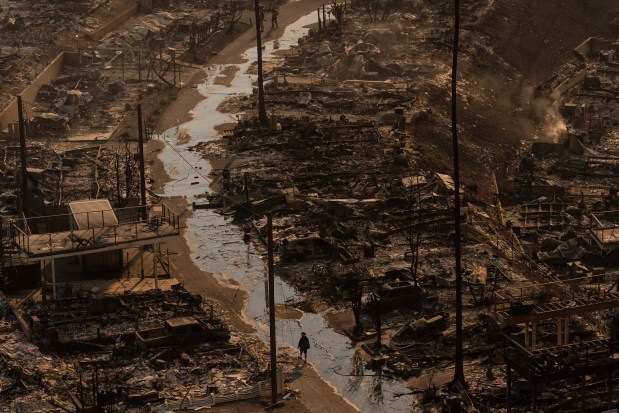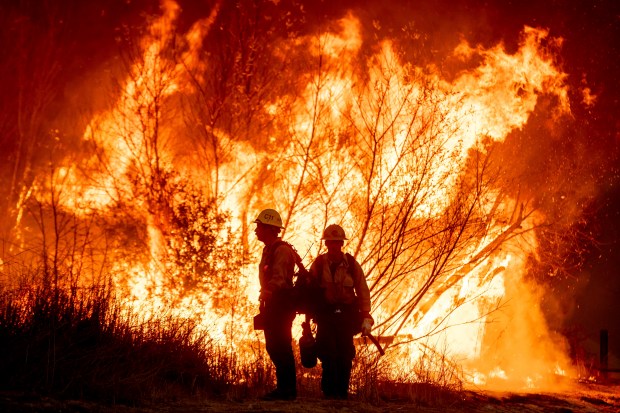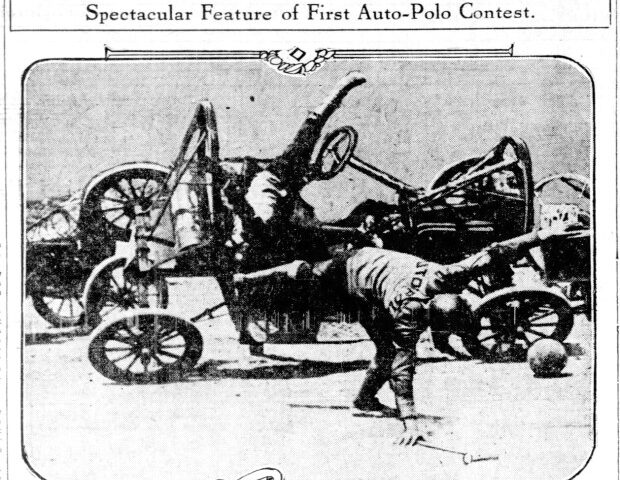While wildfires continue raging across California, destroying thousands of acres of land and homes, sources in snow-covered Lake County point out it has its own history of fires, albeit smaller ones, that wreaked havoc over the years.
Local officials and historians talked about the county’s fire mitigation efforts and emergency response procedures today, and shared stories of major fires in the county’s past.
According to the Cook Memorial Public Library, in 1895 Libertyville had one of its biggest historical fire disasters, with an entire business block going up in flames in the early morning hours of Aug. 31.
Lacking a fire department, lines of people carried buckets to fight the flames, and two buildings were dynamited to stop the spread. Some of the community’s earliest buildings were destroyed by the time the fire was out, and several businesses suffered staggering losses.
A more recent disaster in Zion was recalled by Al Westerman, a former Lake County Forest Preserves president, who recalled the night of Feb. 6, 1954, when he was a young child.
His family lived about six miles away from downtown Zion. It was a Saturday night, Westerman said, and his parents had been throwing a birthday party.
“I was upstairs getting ready for bed, and all of a sudden I looked to the south out of the window, and Zion was all aglow in this orange color,” he recalled. “I go downstairs and tell my dad … and he and his friends all go in the car and took off.”
A Zion department store on Sheridan Road had gone up in flames, and strong winds had blown embers across the straight, catching on a curtain factory across the road. Westerman didn’t see the fire himself, but he recalled going down Sheridan Road afterward.
“It was just a total disaster,” he said. “I mean everything was gone. There was nothing there. All that was, was the brick walls.”

But looking at the news today, Westerman said he’s more reminded of the regular brushfires Lake County used to see in the 1950s and ’60s. Back in the day, he said young troublemakers or errant sparks from freight trains would start fires.
“In the evening, the whole sky would be lit up with the glow of all the flames,” he said.
The Lake County Forest Preserves has since implemented fire mitigation efforts, including carefully considered prescribed burns. Westerman recalled some of the burns he witnessed during his time on the Forest Preserves Board, seeing the terrible power fires can have.
“If you’re dealing with a forested area, those flames are generally very low,” he said. “But if you get into a prairie area, particularly in the marshlands, you could have flames shooting up 20, 30 feet high. It sounds like a freight train going across it.”
While the crew and equipment back then were minimal, today there is a wide array of manpower and equipment available to respond to a wildfire. Pati Vitt, director of natural resources with the Lake County Forest Preserves, said most areas have a burn interval — or the number of years between prescribed burns — of about four years or less.
That reduces the fuel load for any potential uncontrolled fires, Vitt said. Lake County’s natural areas also have a mix of habitat types, and are interspersed with roads, rivers and trails that act as natural fire breaks. That also reduces large-scale fire risks compared to the situation in the western U.S.
“It’s just not going to go very far, and it’s not going to do very much damage, because there’s just not enough fuel to carry it along,” Vitt said. “That’s the goal.”
The forest preserves has its own extensive resources to draw on to combat fire, Vitt said, and also can rely on regional resources if need be.
Jeff Steingart, chief administrative officer for the Mutual Aid Box Alarm System Divisions 4 & 5 and head of Lake County’s Specialized Response Teams, emphasized that agencies in the region “have a plan” for such emergencies.
As local officials explained, the scale of the California fires is far beyond anything possible in Lake County.
“The biggest fire that I’ve seen in my 40 years is probably four or five hundred acres at Illinois State Park,” Steingart said. “That was prairie grass.”
That’s nothing compared to the tens of thousands of acres already burned in California. The pure scale is different, Vitt said, because of the fuel loads seen out west. Evergreen trees and conifers “go up like candles,” and communities are built into nature far more than in Lake County, Vitt said.
For Lake County, Vitt emphasized the importance of prescribed burns to mitigate future fire risks.
“Our habitats evolved with fire,” Vitt said. “Our woodlands are maintained by fire, as are our grasslands. The ecological history of our habitats is to have fire on the ground routinely, and that’s part of our management strategy.”





